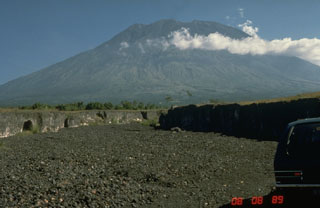Report on Agung (Indonesia) — 4 October-10 October 2017
Smithsonian Institution / US Geological Survey
Weekly Volcanic Activity Report, 4 October-10 October 2017
Managing Editor: Sally Sennert.
Please cite this report as:
Global Volcanism Program, 2017. Report on Agung (Indonesia) (Sennert, S, ed.). Weekly Volcanic Activity Report, 4 October-10 October 2017. Smithsonian Institution and US Geological Survey.
Agung
Indonesia
8.343°S, 115.508°E; summit elev. 2997 m
All times are local (unless otherwise noted)
On 5 October PVMBG reported that the rate of volcanic earthquakes at Agung had not increased during the previous 12 days, but continued to fluctuate at a high level. The seismic network detected 1-3 earthquakes per minute on average, with a total more than 600 events per day. The number of shallow volcanic earthquakes increased to 200 per day during 24 September-5 October, possibly indicating that magmatic activity at shallow depths was still high. The number of earthquakes felt by staff at the Mt. Agung Volcano Observatory in Rendang village, 12.5 km SSW, peaked on 27 September and then decreased afterwards. Gas plumes rose 50-200 m above the crater rim. Satellite data indicated an area of water expulsion near the solfatara field on the crater floor thought to reflect a disturbance to the hydrologic system in response to intruded magma at depth. On 5 October BNPB reported that the number of evacuees reached 146,797 (spread out in 427 shelters), though about 28 villages (70,000 people) were located within the evacuation zone. About 10,000 farm animals had also been evacuated. On 7 October a white plume likely composed mostly of water vapor rose 1.5 km above the crater rim and slowly drifted E. During 8-10 October fumarolic plumes rose 50-200 m above the rim. The Alert Level remained at 4 (the highest level on a scale of 1-4) with the exclusion zone at 9 km, and an additional expansion to 12 km in the SE, S, and SW directions.
Geological Summary. Symmetrical Agung stratovolcano, Bali's highest and most sacred mountain, towers over the eastern end of the island. The volcano, whose name means "Paramount," rises above the SE rim of the Batur caldera, and the northern and southern flanks extend to the coast. The summit area extends 1.5 km E-W, with the high point on the W and a steep-walled 800-m-wide crater on the E. The Pawon cone is located low on the SE flank. Only a few eruptions dating back to the early 19th century have been recorded in historical time. The 1963-64 eruption, one of the largest in the 20th century, produced voluminous ashfall along with devastating pyroclastic flows and lahars that caused extensive damage and many fatalities.
Sources: Pusat Vulkanologi dan Mitigasi Bencana Geologi (PVMBG, also known as CVGHM), Badan Nacional Penanggulangan Bencana (BNPB)

